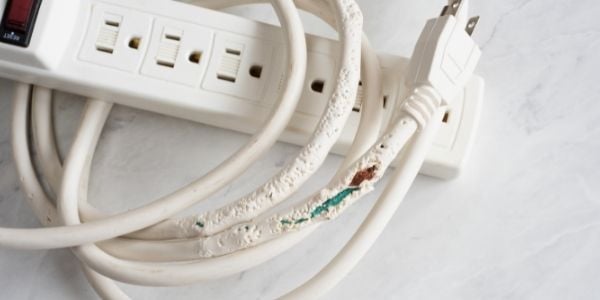 Electrocution from chewing on live electrical cords is the single most common type of electrical injury in dogs and cats.
Electrocution from chewing on live electrical cords is the single most common type of electrical injury in dogs and cats.
It can cause burns to the skin (electrothermal burns) and may even be fatal if your pet is not found and seen by a veterinarian ASAP.
How to Know If Your Pet Has Been Electrocuted?
If you didn’t see the event occur (or even if you did but aren’t sure) and you suspect your pet may have been electrocuted, it’s imperative that you have them evaluated by a veterinarian immediately. There is the possibility of a delayed response to being electrocuted. Read on to know what to look out for.
Skip to:
Symptoms of Electrocution Your Dog or Cat May Be Displaying
- Vomiting
- Yelping/crying/whimpering
- Breathing heavily (respiratory distress)
- Excessive drooling
- Burns to the tongue, mouth, and face
- Singed hair (burning hair smell may be apparent)
- Irritation at the site of contact (e.g., pawing their mouth)
- Involuntary muscle spasms
- Seizures
- Unconsciousness
Even if you don't see these symptoms, if you see chewed or exposed electrical cord(s), that may be evidence of a possible electrocution. Your pet may have burns and is suffering through the pain. You may not notice the burns until they become infected.
Questions? If you are concerned your pet was electrocuted and would like to speak with a veterinarian, Click here
What to Do If Your Pet Has Chewed an Electrical Cord or Has Been Electrocuted
First.
If your pet is still holding onto or touching the electrical cord, turn off the electricity at its source (circuit breaker or fuse box) if possible. This is to disconnect the current from continuing to course through your pet’s body. Do not touch your pet until you've disconnected the source of electricity to avoid you being electrocuted. And do not touch the cord or pull the plug from the outlet.
If you’re unable to turn off the electricity at its source, you need to move your pet away from the source safely. By using a long non-conductive object such as a wooden broom handle or a similar object, you should move your pet away from touching the electrical cord or the electricity source. Once they are safely away, you can now touch your pet without risk of being electrocuted.
Second.
Once you and your pet are safely clear of the electrical source, determine if your pet is stable. If your pet is standing and moving around, this does not mean they haven’t been injured, and you should still have them seen by a veterinarian as soon as possible, as damage from electrocution can be internal as well as external. So, even if you don’t see any external injuries, it doesn’t mean your pet doesn’t have significant internal trauma.
If your pet is unconscious, you should check your pet’s pulse and respiratory rate to determine if they are abnormal or not.
How to check your pet's respiratory rate
Count the number of breaths your pet takes over 15 seconds and multiply it by 4 = how many breaths in 1 minute. A rise and fall of your pet’s chest = 1 respiration. If you don’t see any rise and fall of their chest, their tongue is blue, purple, or pale white, get to an animal ER immediately.
Consequently, if your pet is persistently taking more than 60 breaths per minute at rest or is having trouble breathing, it is also critical that you seek immediate veterinary attention.
Normal dog and cat respiratory rates in breaths per minute (bpm)
No matter the size of your pet, the average respiratory rate is the same, between 15 and 30 breaths per minute.
- Cats: 15–30 bpm
- Small dog/puppies: 15–30 bpm
- Large dogs: 15–30 bpm
To check your pet's respiratory rate, you can do this in one of three ways:
- Place your ear next to your pet’s nose and mouth and listen for breathing sounds
- Place your hand on the side of your pet’s chest and see if it rises with breath
- Feel for air movement out of your pet’s nostrils. You can also use a tissue in front of their nose to see if it moves with any airflow.
How to check your pet's pulse rate
You should also simultaneously check your pet's pulse rate. You can do this one of two ways:
- Place 3–4 fingers on the inside of their rear leg around the mid-thigh. This is where the femoral artery runs, and you should feel it pulsing near the surface. It is easier to find if your dog is standing up.
- Or, by placing your hands on either side of their chest behind the elbows, over their heart to try and feel it beating to count the pulse rate.
Just as with respirations, you count the number of beats you feel during a 15-second period and multiply by 4 to get the beats per minute.
Normal pulse rates for dogs and cats in beats per minute (bpm)
- Cats: 140–180 bpm (+/- 20 bpm)
- Small dog/puppies: 100–140 bpm (+/- 20 bpm)
- Large dogs: 70–120 bpm (+/- 20 bpm)
If you believe your pet’s heart and/or breathing have stopped, it is recommended you have your pet seen immediately by a veterinarian. You can attempt to give CPR in the interim – while on the way to a hospital.
For instructions on how to administer CPR, check out this video.
What Happens When a Pet Is Electrocuted?
Electrocution can cause multiple different types of injuries, from minor to major external and/or internal injuries. However, the longer a pet is exposed to the current is usually the major variable that causes the differences in the type of injuries, and the greater the damage will be.
Electricity, when it comes into contact with a physical body, can cause muscular spasms. This means, that if your pet bites into a live electric cable, the muscles in their jaw may end up spasming and closing around the cable, making it difficult for them to let go, thus increasing the time they are electrocuted and worsening any injury. Additionally, the live current may still be present when you locate them and could shock you as well if you were to immediately touch your pet. Therefore, as mentioned above, the first step when finding an electrocuted pet is to turn the power off at its source if possible.
Types of injuries:
There are typically two categories of injuries that result from electrical cord trauma.
- Local injuries – or electrothermal burns. These are physical burns that occur at the site of contact with the electrical current. So, if a pet was to bite an electrical cord, the burns are typically found in and around the mouth, gums, lips, or tongue. They often appear pale yellow, grey, or tan in color, occasionally even black. Singed hair or whiskers may be seen on occasion around their face or mouth.
- Systemic injuries (injuries affecting the whole body) – this is a result of the electrical current coursing through a pet’s body and causing damage to internal organs. These injuries can range in severity from mild to life-threatening. They can affect any or multiple organ systems, which means that symptoms can appear as almost anything and may appear as any of the following: vomiting, abdominal pain, muscle spasms, seizures, unconsciousness, respiratory distress, fluid accumulation in the lungs, irregular heart rate and rhythm, cardiac arrest, and sudden death.
Conditions as a result of electrocution
Respiratory Distress
Electrocution can result in respiratory distress (trouble breathing) because of the buildup of fluid within the lungs. Known as non-cardiogenic pulmonary edema. (Pulmonary Edema = an accumulation of fluid within the lungs.)
Typically, the most common cause of pulmonary edema when a pet has not been electrocuted is due to heart failure, which is referred to a cardiogenic pulmonary edema. Hence, when a pet is electrocuted, we term it NON-cardiogenic as it is not a result of heart (cardiac) issues. This is also one of the most serious and potentially life-threatening consequences of electrocution.
Typical symptoms include:
- Increased respiratory rate, such as panting or fast breathing, when at rest = Tachypnea
- Difficulty breathing (deep, heavy breaths) = Dyspnea
- Coughing/gagging
- White/pink fluid or foam coming from the nose and/or mouth
- Discolored (blue/grey/white) gums
However, the complicating factor of this symptom is that its onset may be delayed up to 12–36 hours due to the often slow accumulation of fluid within the lungs. Therefore, close monitoring of your pet’s respiratory rate and effort for several days is very important after an electrocution event. And, if your pet develops any of the signs above, then immediate veterinary attention should be pursued.
Questions? If you are concerned your pet was electrocuted and would like to speak with a veterinarian, Click here
Diagnosis
Diagnosis is achieved via x-rays (radiographs), where fluid can be visualized within the lung sacs (alveoli) that should be holding air. In an emergency/life-threatening situation where time is of the essence, a skilled ER veterinarian may be able to visualize ‘lung rockets’ or this same fluid in the alveoli (the air sacs) using a mobile ultrasound unit that is much easier to access and faster to use and obtain images within an ER setting.
Treatment
Typical treatment requires hospitalization with oxygen support, administration of any necessary medications, close monitoring, and in severe cases, mechanical ventilation may be required. Your pet could be in the hospital for 2–3 days or even longer, depending on the severity of the injuries they sustained.
Cardiac Abnormalities
Electrocution can result in damage to the heart muscle, which can cause irregular heart rate(s) (tachycardia or bradycardia) or heart rhythms (arrhythmia). These irregularities can also be potentially serious & life-threatening.
The irregularities may occur immediately and only last a few seconds or the onset may be delayed requiring treatment or may, in the worst case, fatal.
Signs of abnormal heart rates/rhythms include:
- Weakness/collapse
- Agitated behavior/restlessness
- Pale/grey/white gum color
- Difficulty breathing
If your pet develops any of the signs above, immediate veterinary attention should also be pursued.
Diagnosis
Diagnosis is typically established first by manual auscultation of (listening to) the heart via a stethoscope by a veterinarian and confirmation obtained via EKG (electrocardiography or ECG/electrocardiography).
Treatment
Typically involves hospitalization for close monitoring with EKG leads and administration of anti-arrhythmia medications until the heart rate and/or rhythm is controlled.
Be Aware of Delayed Onset Electrocution
Be aware that some pets who have been electrocuted may experience a delayed onset of symptoms, particularly in cases such as small burns that become infected. Your pet may not exhibit signs of discomfort until a burn becomes infected, or as in the cases described above until fluid starts to fill up in the lungs (more critical cases).
Therefore, pets who are known to have been electrocuted should be monitored closely even if they appear to be ok at the time. And if you aren’t aware that electrocution occurred, if you do begin to notice any of the following, it is critical that your pet be seen by a veterinarian for evaluation.
- Pain at the possible site of shock (mouth pain, lameness, etc.)
- Coughing
- Trouble breathing
- Difficulty eating
- Increased drooling
- A foul odor to their breath
How to Prevent Electrocution from Electrical Cords
Typically, most pets live in environments where there are many electrical cords readily accessible for them to chew on. However, it is more common that younger cats and dogs are the main culprits. Usually, from the age they are brought home (around 8 weeks) up to around 2 years (on average), they are in the age group most commonly afflicted as they often view electrical cords as chew toys, thus getting themselves into trouble.
However, dogs and cats of all ages, sizes, and breeds are still known to get themselves into trouble and can and will chew on electrical cords from time to time, especially if left alone unsupervised.
Given chewing on electrical cords is the most common cause of electrocution in pets, prevention of this catastrophe at home is important. And most cases of electrocution because of chewing on an electrical cord in the home are preventable by taking the following steps:
Discourage pets from chewing electrical cords
Training: Pets should be prevented from chewing cables by using management and pet-proofing your home. If you catch your dog chewing on a cord, interrupt immediately and redirect them to an appropriate chew toy or other activity.
Dogs have an innate need to chew. Be sure to provide them with appropriate chew toys, mental enrichment, and enough physical exercise. By providing enticing and dog-safe alternatives for them to chew on, they are less likely to seek out dangerous options like cords. Even so, it’s safest to gather cords and use safety measures like cord covers or otherwise making any cords inaccessible to a curious pup.
If, for some reason, your dog seems magnetized to electrical cords beyond the safety measures mentioned above, you can teach your dog to Leave It. How you train this is important. You want this behavior to be automatic, not rely on your saying “leave it” when you notice your dog meandering towards the cords.
If you catch your cat chewing a cord, positively redirect them to an approved option for chewing, such as a chew-safe toy or cat-safe plant like catnip. And reward them anytime they use this acceptable chewing option in the future.
Deterrents: You can cover cords with pet-safe bitter-tasting sprays to help deter them from biting any cords. Make sure to spray onto a cloth and then rub it onto the cords, as opposed to spraying directly on the electrical cords and devices.
Note about Bitter Sprays for Dogs & Cats: It is our view at Preventive Vet, and especially that of our certified dog trainer and certified cat behavior consultant, that these spray-on deterrents can give pet owners a false sense of security. There are dogs and cats who don’t seem to find the taste deterring at all. The spray will evaporate over time and requires frequent application. A chewing deterrent spray is no guarantee that your pet will not chew on a cord. Physical barriers and safety measures are safer and more effective.
Prevent pets from accessing electric cords, cables, and power bars
Deterrents: Use extension cords to move accessible cords out of reach of pets, such as behind furniture and closer to walls, to prevent access. And cover the exposed cords appropriately. There are several products that work well. Our teammate uses the tubing covers and paints them to match the wall or baseboard. You can see what she uses, as well as other fire-safety solutions, in this article about pets starting fires!
You can also use cable management boxes.
Switching off the power: It’s great to get into the habit of switching off sockets and power bars or unplugging cords when they are not in use. This way, if a pet does happen to chew on an electrical cord, there is less chance of them being electrocuted.
Offer chewing alternatives: Provide plenty of chew toys and other options for mental stimulation, so they are less likely to be tempted by cables. Check out our favorite chew toy and interactive toy options for dogs, and mental enrichment games and activities for cats.
If your dog or cat hasn't typically been interested in chewing cords or cables in the past but suddenly becomes obsessed, then it's time to have your pet seen by a veterinarian, as conditions like stress, dental issues, PICA, etc. can cause a pet to suddenly seek out inappropriate things to chew on.
Be extra careful around the holidays
Given electrocution from chewing on electrical cords is the single most common type of electrical injury in pets, this issue is often escalated during the festive season. This is a result of the many decorative electrical lights that aren’t often well concealed as well as heaters used during these cooler months. If you have cats and they climb your Christmas tree, check out our tips for keeping them safe.
However, keep in mind the list of electrical cords that could pose at other times throughout the year, as the list is endless! Such as those from air conditioners, fans, computers, laptops, as well as phone chargers.
Natural Disasters and Stray Voltage
Even though electrocution from chewing on live electrical cords is the most common form of electrical injury in our pets, there are others that are worth mentioning – the most notable being stray voltage. This often occurs after natural disasters or bad storms that cause live electrical wires to break and fall across roads and sidewalks or even puddles, which may lead to exposure of unseen electrical current, resulting in electrocution. Due to the high voltage of these cables, death is almost always the result.
Thus, it is always recommended after a natural disaster or big storm to be careful where you walk your dog and to keep your cat indoors until clean-up crews have been by to assess the area.
Prevention is always better than cure. In an electrically driven world, while we are strongly becoming wireless, for now, let’s learn and share clever ways to hide the wires from our feline and canine friends to prevent serious injury and potential fatalities. If you have any great tips, please share them in the comments below.







